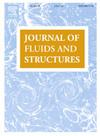Numerical study of consecutive water entries in flowing water with twin spheres side-by-side
IF 3.4
2区 工程技术
Q1 ENGINEERING, MECHANICAL
引用次数: 0
Abstract
A three-dimensional numerical model with six-degree-of-freedom is developed to simulate the side-by-side entry of twin spheres into flowing water. With the explicit volume of fluid (VOF) approach, the shear-stress transport (SST) k-ω model is adopted to delineate the turbulence structures within the flow, while the independent movements of the two spheres are tracked using advanced multi-overset mesh technology. The numerical findings elucidate the effects of water flow on cavity dynamics, flow field evolution, forces, and trajectories during consecutive sphere entries. Distinct flow field characteristics emerge depending on whether the trailing sphere enters the upstream side or downstream side. The flow-induced tilting of the first cavity results in a different scale of expansion of the trailing cavity with respect to that in quiescent water, diminishing the attractive force on the upstream-side sphere and enhancing it for the downstream-side sphere. As the lateral distance between the spheres increases, the forces of attraction and repulsion generated by the leading cavity become marginal in their effect on the trailing sphere's trajectory, particularly when compared with the impact force of the water flow.
流水中并排孪生球体连续进水的数值研究
建立了一个具有六自由度的三维数值模型来模拟双球并排进入流水的情况。通过显式流体体积(VOF)方法,采用剪应力传输(SST)k-ω 模型来划分流体中的湍流结构,同时利用先进的多网格技术跟踪两个球体的独立运动。数值研究结果阐明了连续进入球体时水流对空腔动力学、流场演变、力和轨迹的影响。根据尾部球体是进入上游侧还是下游侧,会出现不同的流场特征。由水流引起的第一个空腔的倾斜导致尾部空腔的扩张尺度与静水中的扩张尺度不同,从而减弱了上游侧球体的吸引力,增强了下游侧球体的吸引力。随着球体之间横向距离的增加,前腔产生的吸引力和排斥力对尾部球体轨迹的影响变得微不足道,尤其是与水流的冲击力相比。
本文章由计算机程序翻译,如有差异,请以英文原文为准。
求助全文
约1分钟内获得全文
求助全文
来源期刊

Journal of Fluids and Structures
工程技术-工程:机械
CiteScore
6.90
自引率
8.30%
发文量
173
审稿时长
65 days
期刊介绍:
The Journal of Fluids and Structures serves as a focal point and a forum for the exchange of ideas, for the many kinds of specialists and practitioners concerned with fluid–structure interactions and the dynamics of systems related thereto, in any field. One of its aims is to foster the cross–fertilization of ideas, methods and techniques in the various disciplines involved.
The journal publishes papers that present original and significant contributions on all aspects of the mechanical interactions between fluids and solids, regardless of scale.
 求助内容:
求助内容: 应助结果提醒方式:
应助结果提醒方式:


